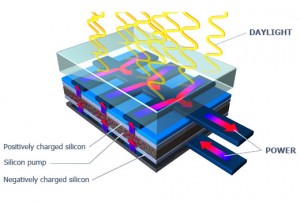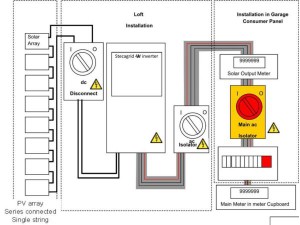How Solar PV works
Solar PV systems use cells to convert sunlight into electricity.  The PV cell consists of one or two layers of semi conducting material, usually silicon. When light shines on the cell it creates an electric field across the layers causing electricity to flow. The greater the intensity of the light, the greater the flow of electricity.
The PV cell consists of one or two layers of semi conducting material, usually silicon. When light shines on the cell it creates an electric field across the layers causing electricity to flow. The greater the intensity of the light, the greater the flow of electricity.
PV cells are referred to in terms of the amount of energy they generate in full sunlight; know as kilowatt peak or kWp.
Types of Solar Cells

Monocrystalline cells are cut from a single crystal of silicon- they are effectively a slice from a crystal.
In appearance, it will have a smooth texture and you will be able to see the thickness of the slice.
These are the most efficient and the most expensive to produce. They are also rigid and must be mounted in a rigid frame to protect them.

Polycrystalline (or Multicrystalline) cells are effectively a slice cut from a block of silicon, consisting of a large number of crystals.
They have a speckled reflective appearance and again you can you see the thickness of the slice.
These cells are slightly less efficient and slightly less expensive than monocrystalline cells and again need to be mounted in a rigid frame.

Amorphous cells are manufactured by placing a thin film of amorphous (non crystalline) silicon onto a wide choice of surfaces. These are the less efficient of the three types. Due to the amorphous nature of the thin layer, it is flexible, and if manufactured on a flexible surface, the whole solar panel can be flexible.
One characteristic of amorphous solar cells is that their power output reduces over time, particularly during the first few months, after which time they are basically stable. The quoted output of an amorphous panel should be that produced after this stabilization.
Solar Panel
A solar panel is a set of solar photovoltaic modules electrically connected and mounted on a supporting structure. A photovoltaic module is a packaged, connected assembly of solar cells. The solar panel can be used as a component of a larger photovoltaic system to generate and supply electricity in commercial and residential applications. Each module is rated by its DC output power under standard test conditions (STC), and typically ranges from 100 to 320 watts. The efficiency of a module determines the area of a module given the same rated output – an 8% efficient 230 watt module will have twice the area of a 16% efficient 230 watt module. A single solar module can produce only a limited amount of power; most installations contain multiple modules.
Solar Array
A photovoltaic array (or solar array) is a linked collection of solar panels. The power that one module can produce is seldom enough to meet requirements of a home or a business, so the modules are linked together to form an array. Most PV arrays use an inverter to convert the DC power produced by the modules into alternating current that can power lights, motors, and other loads. The modules in a PV array are usually first connected in series to obtain the desired voltage; the individual strings are then connected in parallel to allow the system to produce more current. Solar panels are typically measured under STC (standard test conditions) in watts.Typical panel ratings range from less than 100 watts to over 400 watts.The array rating consists of a summation of the panel ratings, in watts, kilowatts, or megawatts.
 Inverter
Inverter
A power inverter, or inverter, is an electronic device or circuitry that changes direct current (DC) to alternating current (AC).
The input voltage, output voltage and frequency, and overall power handling depend on the design of the specific device or circuitry. The inverter does not produce any power; the power is provided by the DC source. In our case it is by solar panels.



